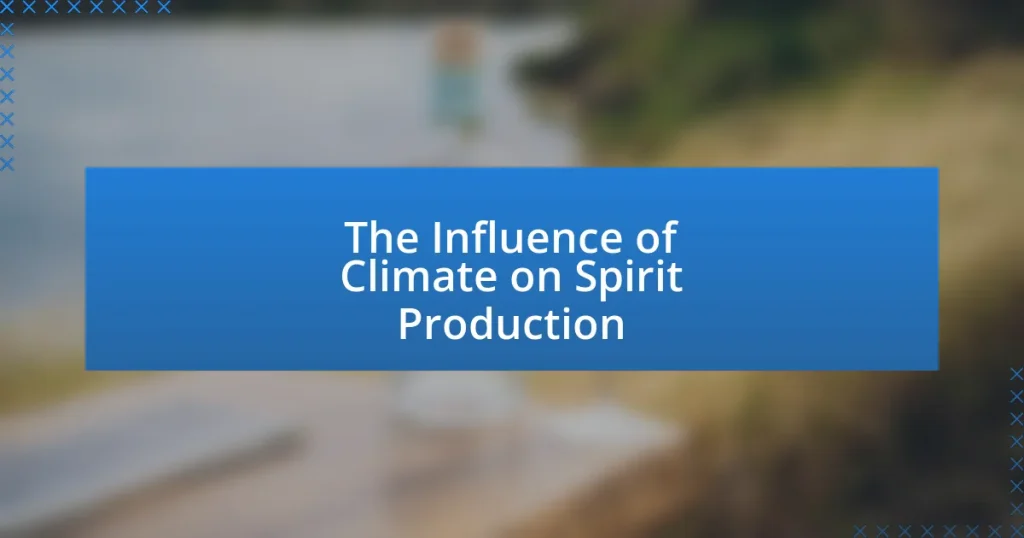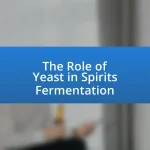The article examines the significant influence of climate on spirit production, highlighting how temperature, humidity, and regional conditions affect the growth of raw materials, fermentation processes, and aging of spirits. It details the ideal climate conditions for cultivating key ingredients such as grains, fruits, and sugarcane, and discusses how these factors impact the quality and characteristics of various spirits like whiskey and rum. Additionally, the article addresses the challenges posed by climate change, including altered agricultural conditions and the need for sustainable practices, while exploring innovations and strategies that producers can adopt to ensure resilience and quality in spirit production.

What is the Influence of Climate on Spirit Production?
Climate significantly influences spirit production by affecting the growth of raw materials, fermentation processes, and aging conditions. For instance, temperature and humidity levels directly impact the fermentation of sugars into alcohol, with warmer climates often accelerating fermentation rates. Additionally, the type of climate determines the availability and quality of key ingredients such as grains, fruits, and sugarcane, which are essential for producing various spirits. Research indicates that regions with specific climates, like the Caribbean for rum production, benefit from ideal conditions that enhance flavor profiles and production efficiency. Thus, climate plays a crucial role in shaping the characteristics and quality of spirits produced in different geographical areas.
How does climate affect the raw materials used in spirit production?
Climate significantly impacts the raw materials used in spirit production by influencing the growth conditions of key agricultural inputs such as grains, fruits, and sugarcane. For instance, temperature and precipitation levels determine the yield and quality of these crops; warmer climates can enhance the sugar content in fruits, while excessive rainfall can lead to crop diseases that diminish harvests. Research indicates that regions with optimal climate conditions, such as moderate temperatures and adequate rainfall, produce higher-quality raw materials, which directly affects the flavor and characteristics of the spirits produced. For example, the production of whiskey relies heavily on barley, which thrives in cooler, wetter climates, while rum production depends on sugarcane, which flourishes in tropical conditions. Thus, climate not only dictates the availability of these raw materials but also their quality, ultimately shaping the spirit’s profile.
What specific climate conditions are ideal for growing key ingredients?
Ideal climate conditions for growing key ingredients include warm temperatures, adequate rainfall, and well-drained soil. Specifically, many crops thrive in temperatures ranging from 20°C to 30°C, with consistent moisture levels of about 600 to 1,200 mm annually. For instance, sugarcane, a key ingredient in rum production, requires a tropical climate with high humidity and temperatures above 20°C to maximize yield. Similarly, grapes, essential for wine production, flourish in regions with warm days and cool nights, which enhance flavor development. These conditions are supported by agricultural studies indicating that optimal temperature and moisture levels directly correlate with crop quality and yield.
How do temperature and humidity influence the quality of these ingredients?
Temperature and humidity significantly influence the quality of ingredients used in spirit production by affecting their chemical composition and preservation. High temperatures can accelerate fermentation processes, potentially leading to off-flavors, while low temperatures may slow down these processes, impacting flavor development. Humidity levels affect the moisture content of ingredients; excessive humidity can lead to mold growth and spoilage, while low humidity can cause dehydration, altering the texture and flavor profile. For instance, studies have shown that optimal fermentation occurs within specific temperature ranges, typically between 20°C to 30°C, which maximizes yeast activity and flavor production. Additionally, humidity levels above 60% can compromise the integrity of grains and fruits, leading to quality degradation.
What role does climate play in the fermentation process?
Climate significantly influences the fermentation process by affecting temperature, humidity, and microbial activity. Higher temperatures can accelerate fermentation rates, while lower temperatures may slow them down, impacting the flavor and alcohol content of the final product. Additionally, humidity levels can influence the growth of yeast and bacteria, which are crucial for fermentation. For instance, in warmer climates, yeast tends to ferment sugars more quickly, leading to a faster production of alcohol, as observed in regions like the Caribbean where rum is produced. Conversely, cooler climates, such as those in Scotland for whisky production, allow for a slower fermentation, resulting in more complex flavors.
How do varying temperatures impact yeast activity during fermentation?
Varying temperatures significantly impact yeast activity during fermentation, with optimal temperatures enhancing fermentation rates and extreme temperatures inhibiting yeast function. Yeast, particularly Saccharomyces cerevisiae, thrives best between 20°C and 30°C, where metabolic activity is maximized, leading to efficient sugar conversion into alcohol and carbon dioxide. At temperatures below 15°C, yeast activity slows, resulting in prolonged fermentation times and potential off-flavors. Conversely, temperatures above 35°C can lead to yeast stress, producing undesirable byproducts and potentially causing fermentation to stall. Studies have shown that maintaining temperature within the optimal range can increase fermentation efficiency by up to 30%, underscoring the critical role temperature plays in yeast performance during fermentation.
What are the effects of climate on the duration of fermentation?
Climate significantly affects the duration of fermentation by influencing temperature and humidity levels. Higher temperatures typically accelerate fermentation processes, as yeast activity increases, leading to shorter fermentation times. Conversely, cooler temperatures can slow down yeast metabolism, extending the fermentation duration. For instance, studies have shown that fermentation at temperatures around 30°C can reduce fermentation time by up to 50% compared to fermentation at 15°C. Additionally, humidity levels can impact the evaporation of volatile compounds, which may also affect the overall fermentation duration. Thus, climate conditions directly correlate with the efficiency and speed of fermentation in spirit production.
How does climate influence the aging process of spirits?
Climate significantly influences the aging process of spirits by affecting the interaction between the spirit and the wood of the barrels in which they are aged. Higher temperatures accelerate the expansion and contraction of the wood, allowing for greater extraction of flavors and compounds from the barrel, while humidity levels impact the evaporation rates of alcohol and water, altering the spirit’s concentration and flavor profile. For example, in warmer climates, spirits may age more quickly due to increased interaction with the barrel, leading to a more pronounced flavor development in a shorter time frame compared to cooler climates, where aging can be slower and more subtle. This phenomenon is supported by the fact that spirits aged in hotter regions, such as Kentucky for bourbon, often exhibit richer and bolder flavors compared to those aged in cooler regions.
What climatic factors affect the interaction between spirit and barrel wood?
Temperature and humidity are the primary climatic factors that affect the interaction between spirit and barrel wood. High temperatures can accelerate the extraction of compounds from the wood, enhancing flavor and color in the spirit, while humidity influences the evaporation rates of both alcohol and water, impacting the spirit’s concentration and overall profile. For instance, in warmer climates, spirits may mature faster due to increased wood interaction, as seen in regions like Kentucky, where the hot summers lead to a more pronounced influence of the barrel on the spirit. Conversely, cooler climates may result in slower maturation, allowing for a more subtle integration of wood characteristics.
How does temperature variation during aging impact flavor development?
Temperature variation during aging significantly impacts flavor development by influencing the extraction and evaporation of compounds within the spirit. Higher temperatures accelerate the interaction between the spirit and the wood of the barrel, leading to increased extraction of flavor compounds such as vanillin and tannins, which enhance sweetness and complexity. Conversely, lower temperatures slow down these processes, resulting in a more subdued flavor profile. Research indicates that spirits aged in warmer climates often exhibit bolder flavors due to the rapid maturation process, while those aged in cooler environments develop more nuanced and delicate characteristics. This relationship between temperature and flavor development is critical in defining the final profile of the spirit.

What are the regional variations in spirit production due to climate?
Regional variations in spirit production due to climate significantly affect the types of spirits produced and their characteristics. For instance, warmer climates, such as those found in the Caribbean, are conducive to the production of rum, which benefits from the accelerated fermentation process due to higher temperatures. In contrast, cooler climates, like those in Scotland, favor whisky production, where the slower maturation process in cooler temperatures enhances flavor complexity. Additionally, regions with high humidity, such as those in tropical areas, experience greater evaporation rates, leading to a higher angel’s share, which can intensify the remaining spirit’s flavor profile. These climatic factors directly influence the raw materials available, fermentation rates, and aging processes, ultimately shaping the distinct profiles of spirits produced in different regions.
How do different climates produce distinct types of spirits?
Different climates produce distinct types of spirits due to variations in temperature, humidity, and local agricultural practices that affect the fermentation and distillation processes. For instance, warmer climates, such as those in the Caribbean, facilitate faster fermentation of sugarcane, resulting in rums with unique flavor profiles. In contrast, cooler climates, like those in Scotland, are conducive to the production of whisky, where slower fermentation and aging in oak barrels enhance complexity and depth. Additionally, the local ingredients available, such as grains in colder regions or fruits in tropical areas, further influence the characteristics of the spirits produced. Historical data shows that the geographical origin of spirits, such as tequila from Mexico and vodka from Russia, is closely tied to the climate and agricultural conditions of those regions, reinforcing the relationship between climate and spirit diversity.
What are examples of spirits uniquely tied to specific climates?
Examples of spirits uniquely tied to specific climates include Scotch whisky, which is produced in the cool, damp climate of Scotland, and tequila, which originates from the arid regions of Mexico. The production of Scotch whisky relies on the specific temperature and humidity levels of the Scottish environment, which influence the aging process in oak barrels, resulting in distinct flavor profiles. Similarly, tequila is made from the blue agave plant, which thrives in the warm, dry climate of Jalisco, Mexico, affecting its sugar content and flavor characteristics. These climatic conditions are essential for the cultivation of the raw materials and the fermentation processes, thereby directly impacting the final spirit produced.
How does climate influence the traditional methods of spirit production in various regions?
Climate significantly influences traditional methods of spirit production by affecting the availability of raw materials, fermentation processes, and distillation techniques. For instance, in warmer climates, such as those found in the Caribbean, sugarcane thrives, leading to the production of rum, where high temperatures accelerate fermentation. Conversely, cooler climates, like those in Scotland, favor barley cultivation, resulting in whisky production, where lower temperatures slow fermentation but enhance flavor development. Additionally, humidity levels can impact the aging process of spirits; for example, in humid environments, the evaporation of water from barrels can lead to a higher concentration of alcohol, altering the final product’s taste. These regional climatic conditions directly shape the ingredients used and the methods employed in spirit production, demonstrating the profound relationship between climate and traditional practices.
What challenges do producers face due to climate change?
Producers face significant challenges due to climate change, including altered growing conditions, increased pest and disease pressure, and water scarcity. These challenges directly impact crop yields and quality, which are critical for spirit production. For instance, rising temperatures can lead to earlier harvests and affect the sugar content in crops like grapes and sugarcane, essential for distillation. Additionally, studies indicate that climate change has increased the prevalence of pests, which can damage crops and reduce overall production efficiency. Furthermore, water scarcity, exacerbated by changing precipitation patterns, limits irrigation options, further threatening crop viability. These factors collectively jeopardize the sustainability and profitability of spirit production.
How is climate change impacting the availability of raw materials?
Climate change is significantly reducing the availability of raw materials essential for spirit production. Increased temperatures and altered precipitation patterns affect agricultural yields, particularly for crops like sugarcane, grains, and fruits, which are vital for fermentation processes. For instance, a study by the Intergovernmental Panel on Climate Change indicates that climate change could reduce global crop yields by up to 25% by 2050, directly impacting the supply of these raw materials. Additionally, extreme weather events, such as droughts and floods, further disrupt supply chains and agricultural production, leading to scarcity and increased costs for producers in the spirit industry.
What adaptations are spirit producers making in response to climate change?
Spirit producers are adapting to climate change by altering their agricultural practices, sourcing ingredients from different regions, and investing in sustainable production methods. For instance, many distilleries are shifting to drought-resistant crops and adjusting planting schedules to align with changing weather patterns. Additionally, some producers are exploring alternative fermentation techniques and energy-efficient distillation processes to reduce their carbon footprint. These adaptations are essential as climate change impacts crop yields and water availability, necessitating a proactive approach to ensure the sustainability of spirit production.

What are the future implications of climate on spirit production?
Future climate changes will significantly impact spirit production by altering agricultural conditions for key ingredients like grains and sugarcane. Increased temperatures and shifting precipitation patterns can lead to reduced crop yields, affecting the availability and cost of raw materials essential for distillation. For instance, studies indicate that a 1°C rise in temperature could decrease wheat yields by up to 10%, which directly influences the production of spirits like whiskey. Additionally, climate change may introduce new pests and diseases, further threatening crop stability. These factors collectively suggest that spirit producers will face challenges in sourcing quality ingredients, potentially leading to higher prices and changes in production practices.
How might climate trends shape the future of spirit production?
Climate trends will significantly shape the future of spirit production by altering the availability and quality of key agricultural inputs, such as grains and fruits used in distillation. For instance, rising temperatures and changing precipitation patterns can affect crop yields, leading to potential shortages of essential ingredients like barley for whiskey or grapes for brandy. A study by the Intergovernmental Panel on Climate Change indicates that climate change could reduce global agricultural productivity by up to 25% by 2050, directly impacting the raw materials needed for spirit production. Additionally, increased frequency of extreme weather events may disrupt supply chains, further complicating the production process.
What innovations are being developed to mitigate climate impacts on production?
Innovations being developed to mitigate climate impacts on production include precision agriculture, renewable energy integration, and sustainable packaging solutions. Precision agriculture utilizes data analytics and IoT technology to optimize resource use, reducing waste and enhancing crop resilience against climate variability. For instance, a study by the University of California found that precision farming can increase yields by up to 20% while minimizing water usage by 30%. Renewable energy integration involves using solar and wind power in production processes, which decreases reliance on fossil fuels and lowers greenhouse gas emissions. Additionally, sustainable packaging solutions, such as biodegradable materials, are being adopted to reduce plastic waste and its environmental impact. These innovations collectively aim to enhance sustainability in production while addressing the challenges posed by climate change.
How can producers ensure sustainability in the face of climate challenges?
Producers can ensure sustainability in the face of climate challenges by adopting regenerative agricultural practices, optimizing resource use, and implementing innovative technologies. Regenerative practices, such as crop rotation and cover cropping, enhance soil health and biodiversity, which are crucial for resilience against climate impacts. For instance, a study published in the journal “Agriculture, Ecosystems & Environment” found that regenerative agriculture can increase soil organic matter by up to 30%, improving water retention and reducing erosion. Additionally, optimizing water and energy use through precision agriculture technologies can significantly reduce waste and lower carbon footprints. According to the Food and Agriculture Organization, implementing such technologies can lead to a 20-30% increase in resource efficiency. By integrating these strategies, producers can mitigate the adverse effects of climate change while promoting long-term sustainability in spirit production.
What best practices can spirit producers adopt to adapt to climate influences?
Spirit producers can adopt sustainable agricultural practices, such as implementing water conservation techniques and selecting climate-resilient crop varieties, to adapt to climate influences. These practices help mitigate the impact of changing weather patterns on raw material availability. For instance, using drip irrigation can reduce water usage by up to 50%, while selecting drought-resistant grape varieties can ensure consistent yields despite fluctuating climate conditions. Additionally, integrating agroforestry can enhance biodiversity and improve soil health, further supporting sustainable production in the face of climate change.
How can producers optimize ingredient sourcing based on climate conditions?
Producers can optimize ingredient sourcing based on climate conditions by selecting crops that are well-suited to the specific climate of their region. For instance, understanding local temperature, rainfall patterns, and soil types allows producers to choose ingredients that will thrive, thereby ensuring higher yields and better quality. Research indicates that certain grains and botanicals perform optimally in specific climates; for example, barley grows best in cooler, wetter climates, while corn thrives in warmer, drier conditions. By aligning their sourcing strategies with these climatic factors, producers can enhance both the sustainability and efficiency of their ingredient procurement processes.
What strategies can be implemented to enhance fermentation and aging processes in varying climates?
To enhance fermentation and aging processes in varying climates, producers can implement temperature control, humidity management, and the use of specific yeast strains. Temperature control, such as using insulated fermentation tanks or climate-controlled warehouses, helps maintain optimal fermentation conditions, which can vary significantly between hot and cold climates. Humidity management, achieved through dehumidifiers or humidifiers, ensures that the aging environment is conducive to the desired evaporation rates, which can affect flavor concentration. Additionally, selecting yeast strains that are tolerant to specific climatic conditions can improve fermentation efficiency and flavor profiles. Research indicates that these strategies can lead to more consistent and high-quality spirit production, regardless of external climate variations.


